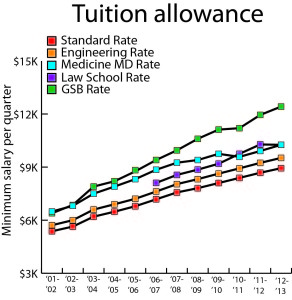Stanford has steadily increased the minimum salary for teaching assistants (TAs) and research assistants (RAs) in recent years as a response to rising graduate student living expenses. A TA must be compensated at least $8,032 this academic year, almost double the $4,940 salary in 2001-02.

Provost John Etchemendy Ph.D. ’82 will likely set a new minimum salary for the 2013-14 academic year in late February. The University provost is responsible for revising the compensation scheme for TAs and RAs each year after reviewing an expense budget report submitted jointly by the Financial Aid Office and the Vice Provost for Graduate Education.
“We try to get it done by late February because all of the graduate programs want to know what these numbers are to determine their next year’s budget,” said Ann George, assistant dean for research and graduate studies.
Salary
TAs and RAs earn a compensation package each year, which includes a salary, covering a student’s projected living expenses, and a tuition allowance.
“The minimum salary is based on estimated student expenses, as published by the graduate student expense budget every year,” George said. “We will commit to a minimum salary for 20 hours per week appointment that will at least cover what we project will be the minimum graduate student expense for the year.”

In the 2012-13 academic year, the estimated graduate student non-tuition expense stands at $8,694. This encompasses on-campus housing, food, transportation, personal expenses and Cardinal Care insurance.
During the academic year, graduate students can be appointed to work a maximum of 20 hours per week and a minimum of four hours per week. If a student is appointed to an assistant position less than the 20-hour maximum, his or her compensation is prorated.
TAs may also qualify for different minimum salary amounts depending on their specified responsibilities.
For instance, the minimum salary is $8,032 for a course assistant, who assists a faculty member in tasks like grading exams, prepping lecture materials and holding office hours; $8,327 for a teaching assistant, who has more independence than a course assistant, demonstrated through tasks like preparing for class sections where new material is presented; $8,596 for a graduate teaching affiliate, who has the primary responsibility for a course and is identified as that course’s instructor in Stanford publications; and $8,596 for a mentor teaching assistant, who coordinates the training of other teaching assistants.
Graduate students, however, frequently perform responsibilities beyond what their appointment suggests.
“They may take on tasks beyond what they are being paid for,” said Sally Gressens, assistant dean for student affairs in the School of Engineering. “Most students do more than the requirement of the job… because they love it.”
There is no maximum amount that a department can pay their graduate TAs and RAs.
“If department feels that they need to pay more to attract students, they could,” George said. “Typically, a student in the natural sciences and biosciences is going to have a higher funding value than our students in the humanities.”
Tuition allowance
While the minimum salary remains the same across all schools in the University, the second part of the compensation scheme– tuition allowance– varies.
For the 2012-13 academic year, tuition allowance stands at $8,940 for an assistant at the Schools of Earth Sciences, Education or Humanities & Science; $9,520 for an assistant at the School of Engineering; $10,260 for an assistant at the School of Medicine; $10,590 for an assistant at the Stanford Law School; and $12,420 for an assistant at the Graduate School of Business (GSB).
These discrepancies reflect the fact that allowances are based on a student’s tuition, according to George. RAs and TAs in the GSB, for instance, receive a higher allowance because their school charges a higher tuition rate.
Despite being compensated in similar ways, TAs and RAs receive their salaries through different funding mechanisms. The University fund TAs directly through allocations to schools and departments. Research grants, however, must cover the bulk of the cost for RAs.
“For TAs, it’s all Stanford money, but for RAs, the grant is typically gotten from the faculty member’s research grant,” George said “To make the most of our research grant, Stanford typically subsidizes a part of the tuition [for RAs].”
Funding for RAs in the School of Engineering is typically obtained from faculty-sponsored research agreements with federal agencies such as the National Science Foundation and Department of Defense, according to Gressens.
With automatic federal budget cuts– which would reduce science and research funding by $57.5 billion over the next five years– on the horizon, the University is expecting increasing difficulty for faculties to obtain the research funding.
“If the sequestration does happen at the end of March, we are concerned that it will become even more difficult for faculty members to get research grants,” George said. “But that is something we have been coping with for a long time.”
